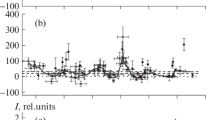Abstract
Observations of young rapidly rotating G-type stars show that a large number of super-powerful flares occur on them. According to the early Sun activity model proposed by (Airapetian et al., 2016), it is assumed that during the first 700 million years there were 250 flares per day with an energy release comparable to the Carrington event of 1859. Within the framework of this model, the high intensity of irradiation of the Earth’s atmosphere by solar cosmic rays (SCR) led to the formation of a large amount of greenhouse gases in ion-molecular reactions. Their high concentration in the atmosphere of the early Earth made it possible to solve the so-called “early Sun” paradox, where high climate temperatures existed on Earth at a reduced luminosity (by 20–30%). We have estimated the possible parameters of early Sun activity from data on the isotope composition of gases in the atmospheres of terrestrial planets. As a result of nuclear reactions of SCR protons with atmospheric gases, the 13C/12C and 15N/14N isotope ratios increase in the atmospheres of planets, since the yields of heavy and light C and N isotopes in nuclear spallation reactions are close, and the initial 13C/12C and 15N/14N ratios in planetary atmospheres are less than 0.01. The production of isotopes depends on the shape of the proton spectrum, the intensity of SCR fluxes, and the composition of early atmospheres. Therefore, modern 13C/12C and 15N/14N isotope ratios in the atmospheres of Venus and Mars give a limit to the activity of the early Sun. Our calculations show that in the Martian atmosphere the 13C/12C ratio should increase by tens of percent, and 15N/14N by several times, which contradicts the measurements. In the atmosphere of Venus, the change in isotope ratios under the influence of SCR is within the limits of the measurement error. Possible explanations of the obtained results are considered, including restrictions on the level of activity of the early Sun and SCR spectra, and the possible composition and mass of the early atmospheres of Mars and Venus.




Similar content being viewed by others
REFERENCES
Airapetian, V.S., Glocer, A., Gronoff, G., et al., Prebiotic chemistry and atmospheric warming of early Earth by an active young Sun, Nat. Geosci., 2016, vol. 9, pp. 452–455. https://doi.org/10.1038/ngeo2719
Allison, J., Apostolakis, J., Lee, S.B., et al., Recent developments in GEANT4, Nucl. Instrum. Methods in Phys. Res., 2016, vol. A835, pp. 186–225. https://doi.org/10.1016/j.nima.2016.06.125
Bezard, B., Balutean, J.P., Marten, A., and Coron, N., The 12C/13C and 16O/18O ratios in the atmosphere of Venus from high-resolution 10-μm spectroscopy, Icarus, 1987, vol. 72, pp. 623–634. https://doi.org/10.1016/0019-1035(87)90057-1
Gillmann, C., Way, M.J., Avice, G., et al., The long-term evolution of the atmosphere of Venus: Processes and feedback mechanisms, Space Sci. Rev., 2022, pp. 218–256. https://doi.org/10.1007/s11214-022-00924-0
Halevy, I., Fisher, W.W., and Eiler, J., Carbonates in the Martian meteorite Allan Hills 84001 formed at 18 ± 4°C in a near-surface aqueous environment, Earth Atmos. Planet. Sci., 2011, vol. 108, pp. 16895–16899. https://doi.org/10.1073/pnas.1109444108
Henderson, P. and Henderson, G., The Cambridge Handbook of Earth Science Data, CUP, 2009. https://doi.org/10.5860/choice.47-2354.
Hoffman, J.H., Hodges, R.R., Jr., McElroy, M.B., et al., Composition and structure of the Venus atmosphere: Results from Pioneer Venus, Science, 1979, vol. 205, pp. 49–52. https://doi.org/10.1126/science.205.4401.49
Hu, R. and Tomas, T.V., A nitrogen-rich atmosphere on ancient Mars consistent with isotopic evolution models, Nat. Geosci., 2022, vol. 15, pp. 106–111. https://doi.org/10.1038/s41561-021-00886-y
Lapen, T.J., Righter, M., Brandon A.D., et al., A younger age for ALH84001 and its geochemical link to shergottite sources in Mars, Science, 2010, vol. 328, pp. 347–351. https://doi.org/10.1126/science.1185395
Maehara, H., Shibayama, T., Notsu, S., et al., Superflares on solar-type stars, Nature, 2012, vol. 485, pp. 478–481. https://doi.org/10.1038/nature11063
Maehara, H., Notsu, S., Notsu, T., et al., Superflares on solar-type stars observed with Kepler. I. Statistical properties of superflares, Astrophys. J. Suppl. Ser., 2013, vol. 209. https://doi.org/10.1088/0067-0049/209/1/5
Notsu, Y., Maehara, H., Hawlee, S.L, et al., Do Kepler superflare stars really include slowly rotating Sun-like stars?—Results, Astrophys. J., 2019, vol. 876, p. 58. https://doi.org/10.3847/1538-4357/ab14e6
Mathew, K.J. and Marti, K., Early evolution of Martian volatiles: Nitrogen and noble gas components in ALH84001 and Chassigny, J. Geophys. Res.: Planets, 2001, vol. 106, pp. 1401–1422. https://doi.org/10.1029/2000JE001255
Pavlov, A.A., Pavlov, A.K., Ostryakov, V.M., et al., Alteration of the carbon and nitrogen isotopic composition in the Martian surface rocks due to cosmic ray exposure, J. Geophys. Res.: Planets, 2014, vol. 119, no. 6, pp. 1390–1402 https://doi.org/10.1002/2014JE004615
Pavlov, A.K., Blinov, A.V., Frolov, D.A., et al., Spatial distribution of the atmospheric radionuclide production by galactic cosmic rays and its imprint in natural archives, J. Atmos. Sol.-Terr. Phys., 2017, vol. 164, pp. 308–313. https://doi.org/10.1016/j.jastp.2017.09.016
Valley, J.W., Eiler, J.M., Graham, C.M., et al., Low-temperature carbonate concretions in the Martian meteorite ALH84001: Evidence from stable isotopes and mineralogy, Science, 1997, vol. 275, pp. 1633–1638. https://doi.org/10.1126/science.275.5306.1633
Webster, C.R., Mahaffy, P.R., and Fiesch, G.R., Isotope ratios of H, C, and O in CO2 and H2O of the Martian atmosphere, Science, 2013, vol. 341, pp. 260–263. https://doi.org/10.1126/science.1237961
Wong, M.H., Atreya, S.K., Mahaffy, P.N., et al., Isotopes of nitrogen on Mars: Atmospheric measurements by Curiosity’s mass spectrometer, Geophys. Res. Lett., 2013, vol. 40, pp. 6033–6037. https://doi.org/10.1002/2013GL057840
Funding
This work was supported by ongoing institutional funding. No additional grants to carry out or direct thisparticular research were obtained.
Author information
Authors and Affiliations
Corresponding authors
Ethics declarations
The authors declare that they have no conflicts of interest.
Additional information
Publisher’s Note.
Pleiades Publishing remains neutral with regard to jurisdictional claims in published maps and institutional affiliations.
Rights and permissions
About this article
Cite this article
Vasiliev, G.I., Melikhova, E.S. & Pavlov, A.K. Isotope Traces of Early Solar Activity. Geomagn. Aeron. 63, 942–946 (2023). https://doi.org/10.1134/S0016793223070253
Received:
Revised:
Accepted:
Published:
Issue Date:
DOI: https://doi.org/10.1134/S0016793223070253




